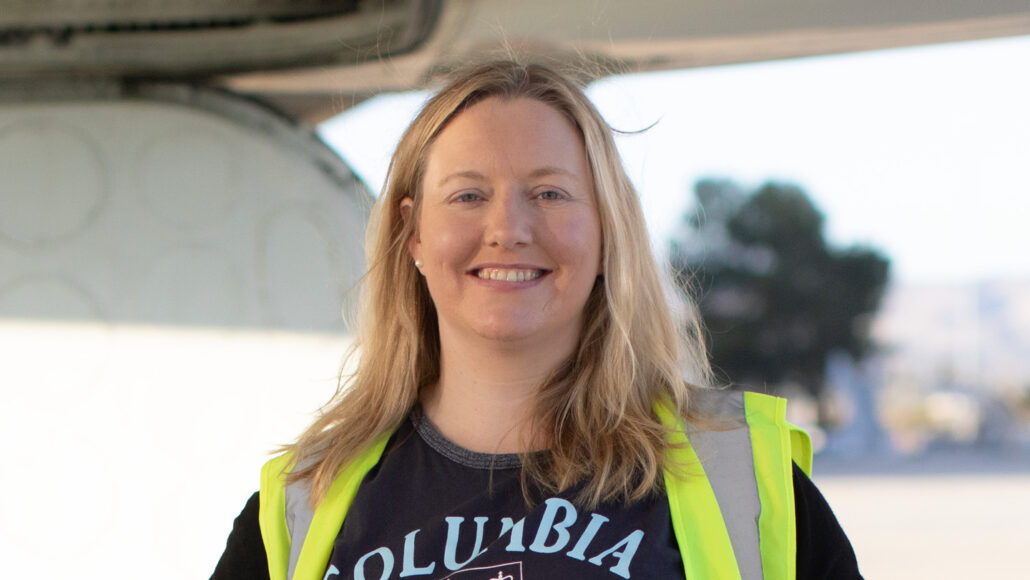Róisín Commane investigates greenhouse gas leaks in the fight against climate change

New York has a greenhouse gas accounting problem. The state broadly tracks its sources of air pollution, from energy production to transportation to waste management, but the books don’t always match what’s actually in the air. The amount of methane over New York City, for example, is puzzlingly higher than expected.
It’s a mystery that Róisín Commane is trying to solve. Part accountant, part sleuth, the Columbia University atmospheric chemist scours the city from pavement to rooftop looking for unidentified or incorrectly cataloged sources of greenhouse gases — and uses this information to improve our understanding of the city’s anthropogenic emissions.
There are two primary strategies to quantify emissions. Bottom-up models calculate total pollution from individual sources using representative values for each type of emissions. Top-down models describe total pollution moving through an area using measurements taken directly from tower sensors or planes.
The challenge lies in reconciling the two, Commane says. “These models can be tweaked to make sure that they represent the atmosphere as we understand it now.”
It’s important work. Urban areas account for about 70 percent of the world’s carbon dioxide emissions, and among cities in the United States, New York City is the leading source of greenhouse gas emissions from human activity.
A better accounting of greenhouse gas emissions could help New York reach its goal of becoming carbon neutral by 2050 and assess how well its reduction efforts are working, Commane says. “We all have great intentions, but if we can show it’s reducing emissions, that’s a much more tangible thing.”
And the findings in New York City could inform similar efforts elsewhere, especially in places with comparable natural gas infrastructure.
Commane compares atmospheric modeling to solving a complicated puzzle. “I’ve always enjoyed playing with numbers,” she says.
After studying chemistry and mathematical physics at University College Dublin in Ireland, Commane got a Ph.D. in atmospheric chemistry at the University of Leeds in England. There, she learned to build tools that measure atmospheric gases, including laser systems.
Atmospheric scientist Steven Wofsy, who advised Commane while she was a research associate at Harvard University, praises her ability to “think about problems holistically.” She’s very creative, he says, pointing to work she did on Arctic carbon. Many existing models focused solely on the summer growing season, when carbon uptake from photosynthesis is at its peak. But Commane extended her experiment to include the winter months, when the ground layer finally freezes and soil microbes that break down and release organic matter as carbon become dormant.
Commane found that, in warmer years, delays in Arctic freezing could lead to enough soil emissions to offset summer uptake and turn the tundra into a net source of carbon dioxide to the atmosphere.
The work in the Arctic is “slightly depressing” because “things are thawing very quickly up there,” Commane says. “The Arctic is suffering from what we’re emitting down here.”
Moving to Columbia University in 2018 to start her own lab gave Commane the opportunity to help address emissions at their source. In addition to New York City’s status as the top source of greenhouse gas emissions in the United States, it ranks third worldwide.
She started by characterizing the city’s greenhouse gases, including carbon dioxide and methane. In collaboration with scientists from the City University of New York, Stony Brook University and the University of Rochester, she developed a network of monitors to sample gases around the city and state.
She also noticed how verdant the city was. New York City is home to an estimated 7 million trees, yet vegetation is left out from most of the city’s carbon accounting models, Commane says.
Commane wondered whether the trees might help explain why carbon emissions measured in the atmosphere were slightly lower than what the bottom-up models predicted. Using the latest high-resolution land cover maps to incorporate vegetation into their model, she and Dandan Wei, a postdoc in her lab, found that the city’s trees were absorbing a surprisingly large amount of carbon dioxide during the afternoon, about 40 percent of the city’s emissions on a summer’s day.
“So the trees do really matter,” Commane says, and models need to account for them. Otherwise, attempts to measure total emissions from human activity in the atmosphere would miss the chunk of carbon that is temporarily taken up by the trees.
As for methane, levels in the air above the city are at least three times as high as those predicted by bottom-up models. But no one knows what causes the excess.
To figure that out, Commane looks for methane relative to other gases, including carbon dioxide, carbon monoxide and ethane. When the sensors pick up large plumes of gas, Commane uses a technique called source attribution to determine how the plumes were produced. Wind speed and plume intensity provide information about the direction to and distance from the source.
Then it’s a matter of hopping into a car or going on foot to measure and confirm the exact location of the emissions with portable sensors, Commane says.
So far, her group has attributed a surprisingly large amount of the unaccounted-for methane to chimneys and rooftops. These are likely due to incomplete combustion of natural gas associated with building heating systems. The researchers also detected localized spikes of methane around certain equipment in now-closed landfills, which could be reduced through engineering solutions that prevent leakage. The largest signals came from older wastewater treatment plants, Commane says, but on the bright side, refurbished facilities barely produced any methane at all.
“The ground-truthing that Dr. Commane is doing is really important,” says Ellen Burkhard, a senior adviser at the New York State Energy Research and Development Authority, the state agency that funds this part of Commane’s research.
“By making these measurements in a sophisticated way, repeatedly, we can characterize the source and [how] that source may change over time,” Burkhard says. “It’s sort of the old adage: You can’t manage what you don’t measure.”
Though Commane continues to work on other projects, she finds the partnership between her lab and the energy research agency particularly rewarding because it’s so solutions-oriented. It keeps her realistic but hopeful in the fight against climate change. “If we didn’t have a way of trying to help fix things, it would feel a lot more futile,” she says. “Here, I can do something about it. And that makes a big difference, I think.”
This article was supported by readers like you. Invest in quality science journalism by donating today.




